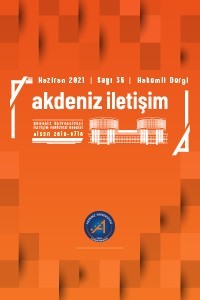Engelli Sporcu Bedenler ve Medya
Bu makalede basındaki söylemin engelli sporculara yönelik önyargıları tetiklediği ve onları ötekileştirdiği iddiasından yola çıkıldı. Bu bağlamda, 2005-2008 yılları arasında Fanatik, Akşam, Zaman, Radikal ve Hürriyet gazetelerinde engelli sporcularla ilgili çıkan haberlerin analizi yapıldı. Haber dili ve kullanılan fotoğraflar irdelendi Türk basınında karşımıza çıkan üç engelli sporcu stereotipine -engelleri aşan, mucizeler yaratan romantik kahramanlar, insani rekabet arındırılmış, bizde acıma ve korku duygularını uyandıran, göz yaşartıcı hikayelerin kahramanları ve müsabakalara renk ya da hoş bir görüntü katan unsurlar- dikkat çekilip, bu stereotipler etik açıdan değerlendirildi.
Anahtar Kelimeler:
Türk Spor Basını, Engellilik, Medikal Model, Sosyal Model, Engelli Sporcular
The Disabled Sporting Body and The Media1
After discussing the philosophical concept of othering this study will focus on the depiction of a “minority group”, namely, disabled athletes in Turkish sports media, i.e., sports pages of mainstream Turkish print media and Turkish sport newspapers. It will be argued that the discourse used by the media leads to the identification of the disabled athletes as the other — as opposed to the “normal”, “able-bodied” athletes. The analysis will focus on the depiction of disabled athletes either as inspirational figures, romantic heroes who transcend their limits, or as tragic heroes who inspire fear and pity, or even sometimes as one of the elements which add color to competitions. It will also discuss how the shock which occurs when expectations based on these stereotypes are not met is depicted in sports media, i.e., when disabled athletes get involved in a fight or a doping scandal. The use of problematic terms such as “against her normal rivals”, “even disabled athletes”, “a pleasant sight”, and “overcoming obstacles” will also be discussed
Keywords:
Sports Disability, Turkish Sports Media, Medical Model, Social Model, Disabled Sports,
___
- Brittain, I. (2004). “Perceptions of Disability and their Impact upon Involvement in Sports for People with Disabilities at all Levels.” Journal of Sport and Social Issues, 28, 4: 429-52.
- Davis, L. J. (1995). Enforcing normalcy: Disability, Deafness and the Body. London: Verso. De Beauvoir, S. (1984). The Second Sex (J. Cape trans). London: Penguin.
- DePauw, K.P. (1997). “The (in)visibility of disability: Cultural contexts and sporting bodies”. Quest, 49: 416-430
- Foucault, M. (1978). The History of Sexuality: An Introduction. (R. Hurley trans.). Harmondsworth: Penguin.
- Gilman, S. (1985). Difference and pathology: Stereotypes of sexuality, race, and madness. Ithaca, NY: Cornell University Press.
- Haralambos, M., Holborn, M. (2000). Sociology: Themes and Perspectives. London: Collins.
- Hargreaves, J. (2000). Heroines of Sport: The Politics of Difference and Identity. London: Routledge.
- Howard L. Nixon, II (2007). “Constructing Diverse Sports Opportunities for People With Disabilities.” Journal of Sport and Social Issues, 31: 417-433.
- Kristeva, J. (1991). Strangers to ourselves. (L.S.Roudiez trans.), New York: Columbia University Press.
- Morris, J. (1991). Pride against Prejudice: Transforming attitudes to disability. London: Women’s Free Press.
- Sands R. G., Krumer-Nevo M. (2002). “Interview Shocks and Shockwaves.” Qualitative Social Work 1, No. 3: 303-318.
- Schwalbe, M., Godwin S., Holden, D., Shrock D., Thompson S., Wolkomir K.(2000). “Generic Processes in Reproduction of Inequality: An Interactionist Analysis’, Social Forces, 79: 419-452.
- Schell, L., Duncan, M. C. (1999). “A content analysis of CBS’s coverage of the 1996 Paralympic Games.” Adapted Physical Activity Quarterly, 16(1): 27-47.
- Schell, L. A. B., Rodriguez, S. (2001). “Subverting bodies/ambivalent representations: Media analysis of Paralympian, Hope Lewellen..” Sociology of Sport Journal, 18(1): 127-135.1.
- Thomson, R. G. (1997). Extraordinary bodies: Figuring physical disability in American culture and literature. New York: Columbia University Press.
- Tufan, I., Yaman, H. ve Arun, O. (2007). “Brief Note: Disability in Turkey.” International Social Work, 50: 839.
- Wendell, S. (1996). The rejected body: Feminist philosophical reflections on disability. New York: Routledge.
- Yayın Aralığı: Yılda 3 Sayı
- Başlangıç: 2003
- Yayıncı: Akdeniz Üniversitesi
